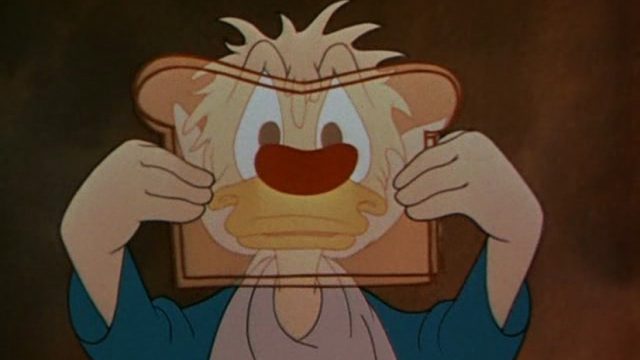It seems astonishing to say now that the Disney studios were courting bankruptcy, but there we are. Some ninety percent of their animation employees were involved in war efforts, but by 1947, of course, that was all over. Walt was a man of . . . not grand ambition, particularly, at least not in the sense people think. But grand imagining. I don’t know that he wanted the fame and glory he ended up with, though I don’t really know enough about Walt the man to be sure. But he had these expansive ideas that took a lot of work—and a lot of money. And the company just couldn’t afford them for much of the ’40s.
This is one of the Disney “package films,” films that only achieve feature length by stringing together two or more shorts. These were considerably cheaper to make and could be recycled later. In this one, Jiminy Cricket (Cliff Edwards) first plays us a record wherein Dinah Shore tells the story of Bongo then sees an invitation for Luanna Patten, a Disney child contract player, to go to a party at Edgar Bergen’s house. There, Bergen tells everyone the story of “Mickey and the Beanstalk.”
Bongo, implausibly enough, is based on a Sinclair Lewis short story. (Actually, glancing over the plot summary of the short story, it does sound awfully Sinclair Lewis, and it’s not as weird as Upton Sinclair’s The Gnomobile, which I can’t even begin to imagine and don’t like Upton Sinclair’s writing enough to seek out and try to understand.) It is the story of a circus bear who escapes into the wilderness to live free as bears live, only to find out that he sucks at that. There is also a love story that never quite gels into an explanation of how he gets on in the wilderness after that.
“Mickey and the Beanstalk” doesn’t, I think, require plot summarization. It’s “Jack and the Beanstalk” only with Mickey Mouse, Donald Duck, and Goofy. Likely you’ve seen it. Possibly you’ve seen it recently; it’s one of the package film segments that gets recycled most often. To the extent that there are four different narrations available. You can have Edgar Bergen, as here, or you can have Ludwig Von Drake, Sterling Holloway, or Shari Lewis and Lambchop, depending on your preference. I think these days, it’s the Von Drake that gets used most often, though I could be wrong.
Basically, the framing device here is “Jiminy Cricket listens to a couple of stories.” Which, okay, fine. That can be a thing, and not all of the package films bothered with a framing device at all. But I think it’s interesting to point out that there was a Disney Studio Universe decades ago, because you would get Jiminy Cricket interacting with Willie the Giant (Billy Gilbert). People aren’t necessarily aware of this in the US, but in other countries, Disney comic books are still popular, and they are swarming with the minor characters. To the extent that the IMDb page for this movie expresses surprise that Lulubelle, Bongo’s love interest, isn’t in any of them.
In case you’re curious, yes, Edgar Bergen noticed that he moves his lips a lot in this movie. And agreed that, yes, it was definitely the result of having spent any number of years doing ventriloquism on the radio. While on the one hand, this isn’t all that different from voice acting, or from the sort of “let’s all try to do silly voices” we do for Saturday Night Script Read, on the other, when he appeared in public, it was still with the puppets. Vaudeville may have been where he’d gotten his start, but years of radio had stolen some of his skill, I think.
There’s something odd about the contrast between the chipper song Jiminy Cricket starts the movie with, which is basically “troubles are all in your head and go away if you ignore them,” and the stark hunger in “Mickey and the Beanstalk.” Oh, Mickey Mouse can’t starve to death, but the world was at that point only a couple of years out of a war where untold numbers did. Yes, the US remained relatively untouched, even given casualties, but it does seem a bit at odds with people’s lived experiences. While the film’s target audience was probably for the first time too young to remember the Depression, that was only just barely true.
Then again, Jiminy Cricket ends the song by almost getting eaten by a cat. He escapes, but that’s still a real problem that wasn’t in his head. Perhaps one of the reasons this film is among the least remembered of the package films is as much its tonal whiplash as the fact that it isn’t terribly good. The “bears express affection by slapping thing” is just random and does not seem to come from the original story. Charlie is rude and sarcastic all the way through “Mickey and the Beanstalk” and actively encourages Willy to eat Our Heroes. Who in the hell wants Mickey Mouse to get eaten?


